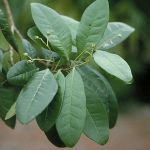| Common Name: |
Pimiento |
| Other Names: |
Jamaica Pepper, Allspice, Pimento, Clove Pepper |
| Botanical Name: |
Pimenta dioica, Eugenia pimento |
| Genus: |
Pimenta |
| Family: |
Myrtaceae |
| Native Location: |
Mexico, C America, and Cuba |
| Cultivation: |
Rich, well-drained, sandy soil in sun. |
| Propagation: |
By seed sown when ripe; semi-ripe cuttings in summer. |
| Harvest: |
Leaves are picked as required and used fresh for infusions. Fruits are collected when fully grown, but unripe and green, and distilled for oil, or dried for liquid extracts and powders; they turn black when dried. Bark is removed from prunings, dried and ground. |
| Height: |
10-15cm (30-50ft) |
| Width: |
5m (15ft) |
| Hardiness: |
Min. 15-18°C (59-64°F) |
| Planet: |
Mars |
| Magickal Uses: |
Burned as an incense to attract money or luck. It is also used to promote healing |
| Parts Used: |
Leaves, fruits (berries), oil |
| Properties: |
A pungent, warming, aromatic herb with a clove-like aroma. It improves the digestion, has a tonic effect on the nervous system, and is locally antiseptic and anesthetic. Oil of pimento is carminative and antioxidant. |
| Medicinal Uses: |
Aromatic, stomachic, carminative, condiment, anti-diarrhea
Internally for indigestion, gas, diarrhea, and nervous exhaustion. Externally for chest infections, and muscular aches and pains.
To treat flatulence, indigestion, tooth pain, and muscle pain. |
| Preparation and Dosage: |
7 grains powdered.
A typical dose of allspice is approximately 2tsp of powder mixed in 1 cup water, or three drops of essential oil mixed with sugar. |
| Possible Side Effects: |
Allspice's side effects include nausea, vomiting, and anorexia. |
| Drug Interactions: |
| Taking allspice with these drugs may increase the risk of bleeding or bruising. |
| Abciximab (ReoPro) |
Antithrombin III (Thrombate III) |
Argatroban |
Aspirin (Bufferin, Ecotrin) |
Aspirin and Dipyridamole (Aggrenox) |
| Bivalirudin (Angiomax) |
Clopidogrel (Plavix) |
Dalteparin (Fragmin) |
Danaparoid (Orgaran) |
Dipyridamole (Novo-Dipirido, Persantine) |
| Enoxaparin (Lovenox) |
Eptifibatide (Integrillin) |
Fondaparinux (Arixtra) |
Heparin (Hepalean, Hep-Lock) |
Indobufen (Ibustrin) |
| Lepirudin (Refludan) |
Ticlopidine (Alti-Ticlopidine, Ticlid) |
Tinzaparin (Innohep) |
Tirofiban (Aggrastat) |
Warfarin (Coumadin, Jantoven) |
|
| Supplement Interactions: |
May interfere with absorption of iron, zinc, and other minerals from food. |
| Culinary Uses: |
Dried fruits and used whole in pickling spices, marinades, and mulled wine; also steeped in rum to make pimento dram, a Jamaican liqueur, and ground for flavoring cakes, cookies, desserts, sauces, ketchups, and chutneys. An essential ingredient of Jamaican jerk dishes (pork or chicken marinated in spices and barbecued). Leaves are infused for tea. |
| Economic Uses: |
Powdered berries are added to medicines to disguise the flavor, and to liniments and bandages. Oil is used in commercial food flavoring; also in perfumery, notably Asian fragrances, and after-shave lotions. |
| Bibliography: |
Encyclopedia of Medicinal Herbs by Joseph Kadans, N.D., Ph.D. Copyright © 1970 Parker Publishing Company, Inc. pg 29
The Encyclopedia of Herbs by Deni Bown Copyright © 1995, 2001 Dorling Kindersley Limited pp 316-317
The Essential Herb-Drug-Vitamin Interaction Guide by George T. Grossberg, M.D. and Barry Fox, Ph.D. Copyright © 2007 by Barry Fox, Ph.D. pg. 32
|

